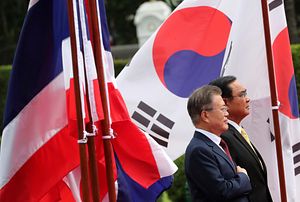South Korean President Moon Jae-in returned last Friday from a weeklong trip to Thailand, Myanmar, and Laos. The timing of the long-planned visit, coinciding with escalating tensions with Japan and growing uncertainty stemming from the U.S.-China trade war, further supports its impetus – Moon’s New Southern Policy.
Initiated to diversify diplomatic and economic ties, the New Southern Policy seeks to upgrade relations with India and ASEAN through the three pillars of “people, prosperity, and peace.” Moon has embraced personal diplomacy in carrying out this new policy, promising to visit every ASEAN country by the end of his term – which he fulfilled on this latest trip – and travelling to India in June. Moon’s most recent trip also reiterated his desire to capitalize on this year marking 30 years of South Korea-ASEAN relations, including through the November ASEAN-Republic of Korea Commemorative Summit taking place in his hometown of Busan.
Though there has been an abundance of symbolism, Moon’s trip emphasized that the New Southern Policy is not short on substance. He showcased existing linkages and launched new initiatives through the lens of the three components of the New Southern Policy. On “people,” Moon highlighted tourism and interest in Korean popular culture, with the trip resulting in MOUs in both Thailand and Myanmar promoting Korean food, cosmetic, and fashion businesses. Further cooperation in fourth industrial revolution industries and sustainable infrastructure development were framed around “prosperity,” backed by the announcement of $1 billion in new infrastructure loans to Myanmar and the inaugural Mekong-Korea summit in November. On “peace,” South Korea signed a General Security of Military Information Agreement with Thailand. Additionally, Moon highlighted how his own agenda aligns with those of his partners, linking the New Southern Policy to Myanmar’s Sustainable Development Plan and Laos’ Five-year National Socio-economic Development Plan, as well as Seoul’s innovation-led growth policy with Bangkok’s Thailand 4.0 policy.
The key question, however, remains whether Seoul’s efforts will be sufficient enough to rebalance toward ASEAN diplomatically and economically. While Moon’s trip was tied to new investment and trade opportunities in the region, South Korea is putting less on the table for ASEAN than Japan and China. For instance, the $1 billion for economic development cooperation with Naypyidaw was a benchmark for Seoul, but it’s dwarfed by Tokyo’s $7.7 billion pledged in 2016. ASEAN countries also significantly trade more with and receive more investment from Chinese and Japanese firms, with Vietnam being the notable exemption. Likewise, South Korea is still heavily dependent on trade with China, despite this reliance being a key driving force behind the New Southern Policy. Last year China was the destination for nearly 27 percent of South Korean exports compared to ASEAN’s 16.5 percent share as a bloc. Further, the Chinese share of South Korea’s total exports jumped up by 2 percent from 2017 to 2018 while ASEAN’s share stayed about the same.
Meanwhile, the urgency of developing stronger ties with Southeast and South Asia continues to grow as Seoul faces new challenges elsewhere. A struggling domestic economy, tensions with Japan spilling over into economic ties, and slowing demand in China exacerbated by the trade war with the United States all underpin the need for finding new sources of economic growth.
Though much has been done, there is still much more work ahead if Seoul wants to dramatically elevate relations with its southern partners. Significantly more economic inroads need to be made among ASEAN countries beyond Vietnam. Doing so could also spur stronger regional cooperation with India, as recently argued by Jagannath Panda, a research fellow at the New Delhi-based Institute for Defense Studies and Analyses. As such, Moon should use the ASEAN-Republic of Korea Commemorative Summit in November to greatly up the ante for his New Southern Policy.
Kyle Ferrier is a Fellow and Director of Academic Affairs at the Korea Economic Institute of America (KEI) and a contributor to The Diplomat’s Koreas blog.

































